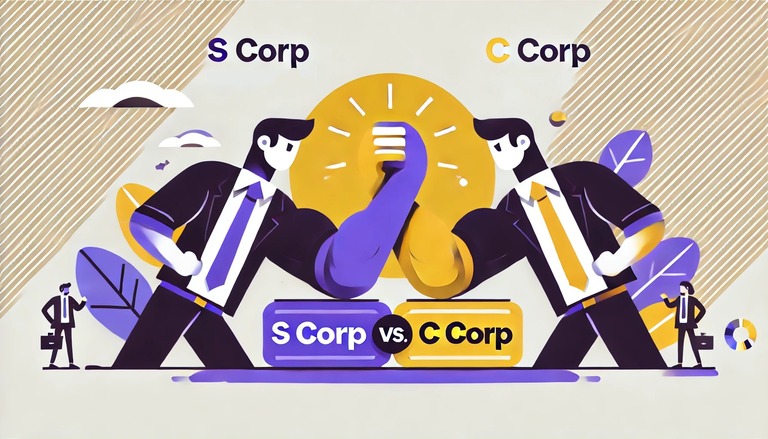What's the difference between an S corporation and C corporation?

Choosing the right business structure is a critical decision for any business owner. The structure you choose will affect your taxes, personal liability, and ability to raise capital.
Among the various options available, S corporations and C corporations are two of the most popular. Understanding the differences between these two structures can help you make an informed decision that aligns with your business goals and financial strategy.
Understanding corporate structures
What is an S corporation?
An S corporation is a special type of corporation that meets certain requirements of the Internal Revenue Code. By electing to be taxed under Subchapter S of the IRS Code, these corporations can pass income directly to shareholders, avoiding double taxation.
S corps are designated by an IRS tax election. This means that they first incorporate as a general corporation (C corp) and then elect S corp status using Form 2553.
One of the main advantages of an S corporation is pass-through taxation. The corporation itself is not taxed; instead, income, losses, deductions, and credits pass through to the shareholders' personal tax returns.
S corporations may have no more than 100 shareholders, all of whom must be US citizens or residents. They may issue only one class of stock, although voting rights may vary.
What is a C corporation?
A C corporation is the standard corporation under the IRS code and is taxed separately from its owners. This structure is favored by businesses that want to scale, attract investors, and offer different classes of stock.
C corps are treated as separate tax entities. They file their own tax returns and pay taxes at the corporate rate. Any profits distributed to shareholders as dividends are taxed again at the individual level, resulting in double taxation.
Unlike S corporations, C corporations can have an unlimited number of shareholders, including other corporations, foreign investors, and various types of entities.
C corporations can issue multiple classes of stock, providing flexibility in fundraising and equity structuring. This allows for different levels of risk and return among investors.
Taxation
Impact of double taxation on C corporations
C corporations are subject to double taxation, which is a significant disadvantage for many small and mid-sized businesses.
Here's how it works:
- Corporate tax. The C corporation files its own tax return (Form 1120) and pays taxes on its net income at the corporate tax rate, which is currently 21% under the Tax Cuts and Jobs Act of 2017.
- Dividend tax. When the corporation distributes its after-tax earnings to shareholders in the form of dividends, those dividends are taxed again at the individual shareholder level. The tax rate on qualified dividends ranges from 0% to 20%, depending on the individual's taxable income.
For example, suppose a C corporation earns $100,000 in profits:
It pays $21,000 in corporate income tax (21% of $100,000).
If it then distributes the remaining $79,000 as dividends, and a shareholder is in the 15% tax bracket for dividends, the shareholder would pay $11,850 in taxes (15% of $79,000).
The total tax paid on the corporation's income would be $32,850, which is a significant portion of the original gain.
Pass-through tax advantages for S corporations
S corporations avoid double taxation through pass-through taxation, which can result in significant tax savings. Here's how pass-through taxation works:
- No corporate tax. The S corporation itself pays no federal income tax on its profits. Instead, it files an informational return (Form 1120S).
- Shareholder tax. Profits and losses are passed through on the shareholders' individual tax returns. Each shareholder reports his or her share of the corporation's income, losses, deductions, and credits on his or her individual tax return and pays tax at his or her personal income tax rate.
For example, suppose an S corporation earns $100,000 in profits and has three equal shareholders:
The S corporation pays no federal income tax.
Each shareholder reports $33,333 of income on his or her individual tax return.
If each shareholder is in the 24% tax bracket, they each pay $8,000 in taxes ($33,333 * 24%).
The total tax paid on the corporation's income would be $24,000 (3 * $8,000), which is significantly less than the combined corporate and dividend taxes for a C corporation.
Also read. How to start an S corporation?
Shareholders and share structure
Number of shareholders limit
- C corporations. There is no limit to the number of shareholders a C corporation can have. This makes C corporations suitable for companies that plan to go public or seek substantial funding from venture capitalists or institutional investors.
- S corporations. Limited to 100 shareholders. This limitation can make it difficult for S corporations to raise large amounts of capital or to expand ownership broadly.
Shareholder eligibility
- C corporations. There are no restrictions on who can be a shareholder. Shareholders can include individuals, other corporations, partnerships, LLCs, and even foreign investors.
- S corporation. Shareholders must be U.S. citizens or residents. In addition, S corporations cannot have partnerships, corporations, or non-resident aliens as shareholders.
Stock classes and flexibility
- C corporations. May issue multiple classes of stock (e.g., common stock and preferred stock). This allows for different voting rights, dividend preferences, and liquidation rights, providing flexibility in structuring the company's capital.
- S corporation. May issue only one class of stock. While they can have different voting rights among shares, the economic rights (such as dividend and liquidation rights) must be identical.
C corp vs. S сorp сomparison
Choosing between an S corporation and a C corporation requires understanding the benefits and drawbacks of each structure. The right choice depends on the specific needs and goals of your business.
| Aspect | C corporation pros | C corporation cons | S corporation pros | S corporation cons |
|---|---|---|---|---|
|
Tax rate |
Unlimited shareholders, facilitating raising capital from a broad investor pool. | Profits are taxed at the corporate level, and dividends are taxed again at the individual level. | Profits and losses are reported on shareholders’ individual tax returns, avoiding double taxation. | Limited to 100 shareholders, all of whom must be U.S. citizens or residents. |
|
Tax rate |
Several share classes are offered. | Complex tax filing. | No corporate tax on dividends. | Limits flexibility in raising capital and structuring equity. |
| Investment attraction | Ability to issue preferred stock and unrestricted shareholder structure. | More stringent regulatory requirements and corporate formalities that require a greater degree of administrative oversight. | Shareholders can deduct 20% of qualified business income under Section 199A. | Must meet strict criteria, including restrictions on types of shareholders and timely filing of Form 2553 with the IRS. |
| Tax rate | The current federal corporate tax rate is 21%, which benefits profitable companies that reinvest earnings. | One class of stock simplifies profit sharing and decision-making. |
Choosing the right structure for your business
Company size and growth plans
- Small to medium-sized businesses. S corporations are often ideal for small to medium-sized businesses that benefit from pass-through taxation and simpler administrative requirements.
- Large businesses. C corporations are better suited for larger companies that plan to scale significantly, attract significant investment, or go public.
Financing needs and investor considerations
- Raise capital. If your business plans to raise significant capital from a diverse group of investors, a C corporation's unlimited shareholders and multiple classes of stock provide greater flexibility.
- Tax efficiency. For businesses where minimizing tax liability is critical, the pass-through taxation of an S corporation can be advantageous, especially if the shareholders are in lower individual tax brackets.
Long-term goals and exit strategies
- Going public. If going public is a long-term goal, forming a C corporation is necessary because of the structure's compatibility with public trading requirements.
- Pass-through benefits. For businesses looking to take advantage of pass-through tax benefits, especially in family-owned or closely-held businesses, an S corporation may be more appropriate.
Drowning in tax details?
Get your free tax consultation
Conclusion
In summary, the choice between an S corporation and a C corporation depends on your company's unique needs, growth plans, and financial strategies. Understanding the key differences in taxation, shareholder structure, and compliance requirements is essential to making an informed decision.
Always seek professional advice to ensure that the structure you choose aligns with your long-term business goals and maximizes your potential for success.
Disclaimer: This article is for informational purposes only and does not constitute legal or tax advice. Always consult with a tax professional regarding your specific case.

Ines Zemelman, EA, is the founder and president of TFX, specializing in US corporate, international, and expatriate taxation. With over 30 years of experience, she holds a degree in accounting and an MBA in taxation. See more
Further reading
![Guide to S corp taxes [+ 25 FAQs answered by tax pros]](https://tfxstorageimg.s3.amazonaws.com/5ive22zs5rfzfaniwnoxx88emcud)
